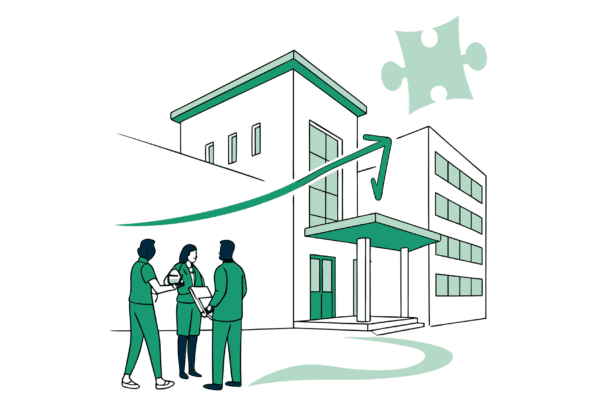The market for neurology is expanding quickly, and in Las Vegas, that growth is amplified by Nevada’s significant physician shortage. This creates a powerful opportunity for practice owners like you. Selling your practice is a major decision that goes beyond just finding a buyer. Proper preparation is the key to maximizing your financial outcome and securing your legacy. This guide provides insight into the current market, valuation, and the steps involved in a successful sale.
Market Overview
The demand for neurological services is growing worldwide. The global market is projected to reach nearly $95 billion by 2029. This growth is driven by an aging population and a higher incidence of neurological conditions. For practice owners, this translates to a larger and more diverse pool of potential buyers, from hospital systems to private equity groups.
Here in Nevada, this demand is even more intense. Every county in the state is officially designated as having a physician shortage. This scarcity means established neurology practices in Las Vegas are highly valuable assets. Buyers are actively looking for well-run practices with a stable patient base to meet the underserved needs of the community. Your practice is not just a business. It is a solution to a significant local healthcare demand.
Key Considerations for Sellers
When preparing to sell, you need to see your practice through a buyer’s eyes. Your revenue is important, but buyers look deeper. They analyze the specific factors that create sustainable value.
Your Unique Service Mix
What do you offer beyond general neurology? Buyers pay close attention to ancillary services like EEG, NCS/EMG, TMS, sleep studies, or Botox treatments. These diverse revenue streams show a robust and scalable business model. Documenting the profitability of each service can significantly strengthen your negotiating position.
The Buyers Math
A potential buyer who is not a neurologist, like a private equity group, must factor in the cost of hiring a replacement physician. In Las Vegas, a neurologist’s salary is around $334,000 per year. This figure is deducted from your cash flow to determine the practice’s true profitability for the new owner. Understanding this calculation is critical to arriving at a realistic valuation.
Legacy and Staff
Your team is one of your most valuable assets. A clear plan for how your staff will be treated after the sale is important to buyers. It shows a stable operation. It is also important for your own peace of mind. Protecting your team and your legacy should be part of the transition strategy from the very beginning.
Your legacy and staff deserve protection during the transition to new ownership.
What We’re Seeing in the Las Vegas Market
The market for neurology practices in Las Vegas is not just theoretical. It is active. We are seeing established practices come to market with strong financials. For example, a practice founded in 2001 with around $800,000 in cash flow was recently listed for $1.75 million. Another, larger practice with over $1.6 million in cash flow is on the market for nearly $4 million. These are not outlier events. They reflect a healthy and dynamic acquisition landscape. Many of these practices are also SBA Prequalified, which makes it easier for buyers to secure financing and speeds up the sale process. Sellers are typically motivated by retirement and are often willing to stay on for a transition period to ensure a smooth handover, which is a feature buyers find very attractive.
The Path to a Successful Sale
Selling your practice is a structured process, not a single event. When managed correctly, it unfolds in predictable stages that protect your interests and maximize value. Here is what the path generally looks like:
- Preparation and Valuation. This is the foundational step. We help you organize your financials, understand your practices true earning power (Adjusted EBITDA), and establish a compelling, data-backed asking price.
- Confidential Marketing. Your practice is never publicly listed. Instead, we create a confidential information memorandum and present the opportunity to a curated database of qualified buyers who have been vetted for financial capacity and strategic fit.
- Negotiation and Offer. We manage initial offers to generate competitive tension, helping you secure the best possible terms. We then work with you to sign a non-binding Letter of Intent (LOI) that outlines the deal structure.
- Due Diligence. This is where the buyer verifies all your financial and operational information. It is the most intensive phase and where many deals encounter problems. Proper preparation beforehand is the key to a smooth and successful due diligence period.
- Closing. Once due diligence is complete, lawyers draft the final purchase agreements. After signing, the funds are transferred, and the transition to new ownership begins.
The due diligence process is where many practice sales encounter unexpected challenges.
Understanding Your Practice’s True Value
Many practice owners think of value in terms of a simple multiple of revenue. The reality is more nuanced and often more favorable. Sophisticated buyers value your practice based on its Adjusted EBITDA. This stands for Earnings Before Interest, Taxes, Depreciation, and Amortization. It is a measure of your practice’s true cash flow. We calculate it by taking your net income and adding back owner-specific expenses, like a high personal salary, car leases, or other non-operational costs. This process often reveals that a practice is significantly more profitable than it appears on paper.
This Adjusted EBITDA is then multiplied by a specific number, the “multiple,” to determine your practice’s enterprise value. This multiple is not a fixed number. It can range from 4x to over 8x depending on factors like your payer mix, your reliance on a single provider, and your potential for growth. An associate-driven practice with multiple revenue streams will always command a higher multiple than a solo practice. Our job is to not only calculate your true EBITDA but to frame the story of your practice to justify the highest possible multiple.
A comprehensive valuation is the foundation of a successful practice transition strategy.
Planning for Life After the Sale
The day you close the sale is not the end of the journey. The structure of your deal has major implications for your finances and your transition into retirement. Thinking about these elements early in the process gives you more control over the final outcome. Some key post-sale structures are negotiated as part of the deal itself.
| Post-Sale Structure | What It Is | Why It Matters |
|---|---|---|
| Transition Period | A defined period (e.g., 3-6 months) where you continue to work in the practice, often on a part-time basis. | Ensures a smooth handover for patients and staff. Provides continuity that is highly valued by buyers. |
| Earnout | A portion of the sale price that is paid out over 1-2 years if the practice hits certain performance targets. | Can help bridge a valuation gap between buyer and seller. Rewards you for the practice’s continued success. |
| Equity Rollover | You “roll over” a percentage of your sale proceeds (e.g., 20%) into ownership of the new, larger company. | This gives you a “second bite of the apple.” You can benefit from the future growth and eventual sale of the larger entity. |
Each of these elements affects your cash at close, your tax liabilities, and your role after the sale. Structuring them correctly is critical to achieving your personal and financial goals.
The right exit approach depends on your personal and financial objectives.
Frequently Asked Questions
What makes Las Vegas a unique market for selling a neurology practice?
Las Vegas, and more broadly Nevada, is experiencing a significant physician shortage, which increases demand for neurological services and makes established practices highly valuable to buyers. This shortage creates a unique opportunity for practice owners due to a growing patient base and fewer local specialists.
What factors do buyers consider when valuing a neurology practice in Las Vegas?
Buyers focus on the practice’s sustainable value including revenue, profitability (measured by Adjusted EBITDA), diverse service offerings like EEG, NCS/EMG, and additional treatments, as well as operational factors such as patient base stability and staff retention plans. They also deduct costs like hiring a replacement neurologist (approximately $334,000/year) when calculating profitability.
How should I prepare my neurology practice for sale to maximize its value?
Preparation involves organizing your financials, calculating your true earning power through Adjusted EBITDA, and documenting profitability of all services offered. A professional valuation that frames your practice‚Äôs growth potential and stability is crucial. Also, planning staff transitions and legacy protection improves your practice’s appeal to buyers.
What is the typical process for selling a neurology practice in Las Vegas?
The process typically involves: 1) Preparation and accurate valuation, 2) Confidential marketing to vetted buyers, 3) Managing offers and signing a Letter of Intent, 4) Due diligence where buyer verifies information, and 5) Closing where final agreements are signed and ownership transitions. Each step is designed to protect seller interests and maximize sale value.
What are common post-sale arrangements for neurology practice owners in Las Vegas?
Common post-sale structures include a transition period where the owner stays on part-time to assist with a smooth handover, earnouts that provide additional payments based on future performance, and equity rollover, allowing the seller to retain a stake in the larger acquiring company. These terms affect cash flow, taxes, and the owner’s role after the sale.



